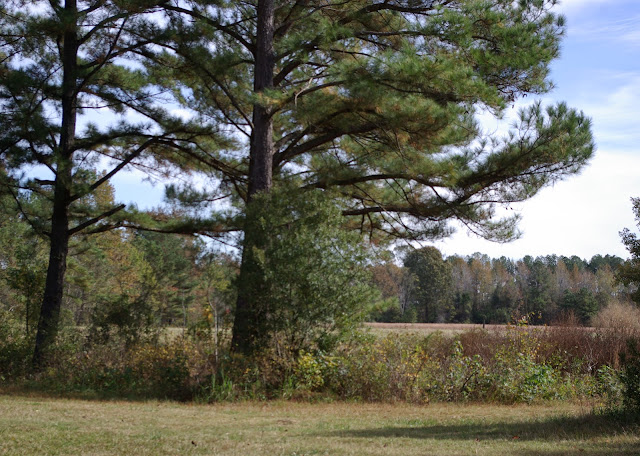The late turners ~ the beech trees, sweetgums and oaks ~ held onto their leaves through Sandy and have looked beautiful the past ten days.
Our farm was logged at some point over 30 years ago, and so we have a lot of fast-growing lowland pioneer trees: loblolly pines, tulip poplars, red maples, sweetgums, willow oaks, and river birches. The sweetgums always seem to be reliable in fall; they are less picky than their more flamboyant brethren the red maples and are beautiful in their own right, first turning gold and then adding red to appear orange, and finally a deep burgundy/ purple. They are the Joseph's coat of fall trees.
This being a mid-successional forest there are many small young beeches, oaks and
hickories in the understory, waiting their turn to dominate the forest. One of the
older youngsters near the old house site glows like a candle when it colors late in the fall.

hickories in the understory, waiting their turn to dominate the forest. One of the
older youngsters near the old house site glows like a candle when it colors late in the fall.

I've always liked this oak at the edge of the neighbor's pasture. It's usually a rich rusty color
but is more of a pumpkin hue this year. It's a red oak of some sort, perhaps a cherrybark oak.

but is more of a pumpkin hue this year. It's a red oak of some sort, perhaps a cherrybark oak.

Willow oaks grow next to a couple of the pastures. They had some color this year, although their best year was after Fran in '99, when they turned a radiant golden yellow. Everything turned brilliant colors that year. The formula for a really good fall in this area seems to consist of a good amount of rainfall in September and early October followed by relatively dry and calm weather after mid to late October.
Even this sweetbay (Magnolia virginiana) has turned yellow. It's tardily deciduous (meaning that it usually doesn't lose its leaves until late winter), and as I recall the leaves usually just turn a bright brown before dropping.
This has been a stellar year for the musclewoods (Carpinus caroliniana), aka ironwood aka American hornbeam. The young trees at the woods' edge have been spectacular cloaked in their yellows, reds, and oranges.
Although serviceberry is known for its beauty in the fall, our wild serviceberries usually prematurely lose their leaves to leaf spot. However, a serviceberry tucked in a semi-hidden spot surprised me ~ although not for the first time ~ with its beautiful bronzy golden and orange colors. I'm glad I saw this, for later that afternoon when I was hunting for young wax myrtles at the edge of our woods I was delighted to find a cluster of tiny serviceberry seedlings of that same golden hue. I potted them to grow up for a year before transplanting elsewhere. There are many treasures to be found near the edges of woods. I found a tiny dogwood seedling (which I left and need to feed so that it will grow and catch up with its parent) and I always see a lot of young blueberries and sweet pepperbush and cinnamon ferns.
This isn't even the end. The blueberries and swamp cyrillas (the very best of all, imo) are peaking just now. Many of the blueberries look like rubies and one of the cyrillas is as orange as a pumpkin. Another is as red as the blueberries.









































